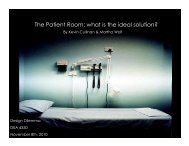The role of physical design and informal communication
The role of physical design and informal communication
The role of physical design and informal communication
You also want an ePaper? Increase the reach of your titles
YUMPU automatically turns print PDFs into web optimized ePapers that Google loves.
LIST OF FIGURES<br />
Figure 1. 6N floor plan.................................................................................................. 27<br />
Figure 2. 6N floor plan showing color-coded location zones...................................... 34<br />
Figure 3. 6N floor plan................................................................................................. 48<br />
Figure 4. View <strong>of</strong> Desk B1 upon entry to the unit....................................................... 49<br />
Figure 5. View <strong>of</strong> work surface from behind Desk B1................................................ 49<br />
Figure 6. View <strong>of</strong> isl<strong>and</strong> work surface from in front <strong>of</strong> Desk B2................................ 50<br />
Figure 7. Charge Nurse <strong>and</strong> Unit Receptionist at Desk B2 ......................................... 50<br />
Figure 8. Telemetry work station at Desk C ............................................................... 51<br />
Figure 9. View <strong>of</strong> med room location from in front <strong>of</strong> Desk B1.................................. 51<br />
Figure 10. View <strong>of</strong> corridor separating nurses’ station from support spaces<br />
from behind Desk B1................................................................................. 52<br />
Figure 11. Sitting area in small break room................................................................. 53<br />
Figure 12. View out <strong>of</strong> break room to elevator lobby.................................................. 53<br />
Figure 13. Existing layout prior to arrival <strong>of</strong> new nurse manager............................... 54<br />
Figure 14. New layout showing changes made by new nurse manager....................... 55<br />
Figure 15. Wall-mounted chart organizer at location A2............................................. 56<br />
Figure 16. Floor plan showing obstructed sightlines <strong>and</strong> limited visibility<br />
across the unit.............................................................................................. 57<br />
Figure 17. Mean RN response to culture section <strong>of</strong> survey......................................... 64<br />
Figure 18. Mean RN <strong>and</strong> GN responses to culture section <strong>of</strong> survey.......................... 66<br />
Figure 19. Overall frequency <strong>of</strong> <strong>communication</strong> tasks by type................................... 69<br />
Figure 20. Average frequency per 8-hour shift <strong>of</strong> <strong>communication</strong> tasks..................... 70<br />
Figure 21. Frequency <strong>of</strong> <strong>communication</strong> tasks that show a pattern <strong>of</strong> change<br />
over time...................................................................................................... 71<br />
Figure 22. Average time <strong>of</strong> a single interaction for each <strong>communication</strong> task............ 73<br />
Figure 23. Average frequency per 8-hour shift <strong>of</strong> who the GN interacted with.......... 74<br />
Figure 24. Weekly frequency <strong>of</strong> who the GN interacted with..................................... 75<br />
Figure 25. Average time during an 8-hour shift the GN spent with each person......... 77<br />
Figure 26. Weekly analysis <strong>of</strong> average time per single interaction with patient<br />
<strong>and</strong> nurse..................................................................................................... 78<br />
Figure 27. Frequency per 8-hour shift <strong>of</strong> where the GN interacted............................. 79<br />
Figure 28. Overall frequency <strong>of</strong> where the GN interacted over 8 weeks <strong>of</strong><br />
data collection.............................................................................................. 80<br />
Figure 29. Average time <strong>of</strong> a single interaction by location........................................ 81<br />
Figure 30. Frequency <strong>of</strong> task by person with tasks grouped to emphasize<br />
Knowledge transfer..................................................................................... 86<br />
Figure 31. Frequency <strong>of</strong> task by person with tasks grouped to emphasize<br />
knowledge transfer...................................................................................... 88<br />
Figure 32. Frequency <strong>of</strong> location by person................................................................. 89<br />
Figure 33. Mean RN <strong>and</strong> GN learning survey responses............................................. 94<br />
Figure 34. Average competency ratings by week <strong>and</strong> GN patient assignment............ 95<br />
Figure 35. Competency ratings by category in weeks 1 <strong>and</strong> 9..................................... 96<br />
viii







